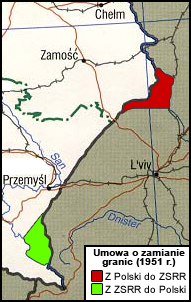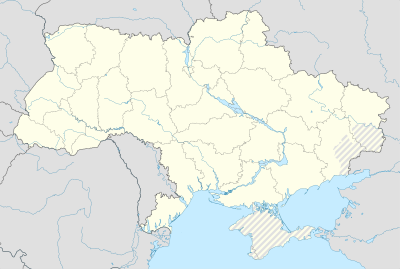Development of the administrative divisions of Ukraine
This article needs additional citations for verification. (December 2023) |
| Part of a series on the |
| Subdivisions of Ukraine |
|---|
 |
| First level |
| Second level |
| Third level |
Administrative divisions development in Ukraine reviews the history of changes in the administrative divisions of Ukraine, in chronological order.
Russian Empire and Ukrainian People's Republic
The Russian Empire had acquired much of the territory inhabited by Ukrainians between the mid 17th and early 19th centuries, which was organized into nine Ukrainian governorates:
After the events of 1917, which led to the
The West Ukrainian People's Republic in former Austro-Hungarian Empire territory was not subdivided into governorates, and would be annexed by the Second Polish Republic from 1920 until the Soviet invasion of 1939.
Overview of Soviet Ukraine (1921–91)
During the existence of the Ukrainian People's Republic and the Soviet Ukraine its administration division went through three changes.[citation needed]
- governorate, 1919–1925
- zemlia, 1918, not fully realized territorial administrative reform
- subdistrict, 1925-1936
- okruha(district)
- oblast, 1936–1991
- raion and district (border okrug)
- raion and district (
Also there existed national raions and national communities (selsoviets). In Ukraine also was established the Moldavian ASSR[clarification needed] and later[when?] also included Crimean ASSR.
National raions of Ukraine (1920s-1930s)
List of known nationality-based raions of Ukraine in the 1920s and '30s:
Bulgarians
- Blahoieve Raion (centered in Velykyi Buialyk), today part of Berezivka Raion (Odesa Oblast)[3]
- Vilshanka Raion (centered in Vilshanka), today part of Holovanivsk Raion, Kirovohrad Oblast[3]
Greeks
- Velykyi Yanisol Raion (Velykyi Yanisol), today part of similar raion Velyka Novosilka Raion (Donetsk Oblast)
- Sartana Raion (Sartana), today part of Kalmiuskyi District of Mariupol
- Manhush Raion (Manhush), today part of Manhush Raion (Donetsk Oblast)
Jews
- Kalindorf Raion (Kalinindorf) (1927-1941), today part of Velyka Oleksandrivka Raion (Kherson Oblast)
- Novozlatopil Raion (Novozlatopil) (1929-1941), today part of Polohy Raion (Zaporizhzhia Oblast)
- Stalindorf Raion (Stalindorf) (1931-1941), today part of Sofiivka Raion (Dnipropetrovsk Oblast)
- Part of RSFSR then
- Larindorf Raion (Pervomayske Raion (Crimea)
- Fraidorf Raion (Fraidorf) (1930-1939), today part of Rozdolne Raion (Crimea)
Crimean Tatars
- Part of RSFSR[clarification needed] then
- Alushta municipality(1930-1944)
- Balaklava Raion(1930-1944)
- Bakhchisaray Raion(1930-1944)
- Sudak municipality(1930-1944)
- Yalta municipality(1930-1944)
- Albat(1935-?)
Poles
- Markhlevsk Raion (Markhlevsk) (1925-1935), today part of Baranivka Raion (Zhytomyr Oblast)
Ukrainians
- Part of RSFSR then
- Ishun Raion (Ishun) (1930-?), today part of Krasnoperekopsk Raion (Crimea)
Germans
- Fritz Heckert Raion ()
- Zeltsi Raion (Zeltsi)
- Karl-Liebknecht Raion (Landau)
- Karl-Marx Raion
- Luxemburg Raion
- Pulinsk Raion
- Rotfront Raion (Waldheim)
- Singtran Raion
- Friedrich-Engels Raion
- Spartakivka Raion (Spartakivka) (see de:Welykodolynske)
- Molochansk Raion (Molochansk), today part of Tokmak Raion (Zaporizhzhia Oblast)
- Part of RSFSR then
- Büyük Onlar Raion (Büyük Onlar) (1930-1938), today part of Krasnohvardiiske Raion (Crimea)
- Thälmann Raion (Qurman-Kemelci) (1935-1938), today part of Krasnohvardiiske Raion (Crimea)
Before World War II
Just before World War II, Hungary with the help from Poland occupied
In the fall of 1938, the southwestern territories of
In 1939, Carpatho-Ukraine was overrun by the Kingdom of Hungary.
Some of the newly acquired territories in 1939 were annexed and incorporated as Kárpátalja. Kárpátalja unlike most of the country, however, had a special administrative system with the intention of it being governed by the Ruthenian minority population. In practice, it was not the case. Kárpátalja was divided into three administrative delegations (közigazgatási kirendeltség) which were each divided into four districts (járás). The previously annexed territories of 1938 were divided into Bereg County and Ung County.
World War II



In 1939 and 1940, the Soviet Union launched an offensive into eastern Poland and eastern Romania. During these operations, the territories of
After the German invasion of 1941, Ukraine was split between three countries, Germany, Romania, and Hungary. Within Germany Ukraine also was divided between the General Government (Krakau), Reichskommisariat (centered in Rivne), and Wehrmacht administration closer to the Eastern Front.
General Government
Reichskommissariat Ukraine
Most of Ukraine was under a "civil administration" of Reichskommissariat Ukraine with capital in Rowno. Some territories also included former parts of Belarus. Reichskommissariat was divided into five General-bezirke and one Teil-bezirke Taurien (Krim):
- Wolhynien und Podolien (Luzk) - 25 Kreisgebiete,
- Shitomir - 17 Kreisgebiete,
- Kiew - 24 Kreisgebiete,
- Nikolajew - 13 Kreisgebiete,
- Dnjepropetrowsk - 16 Kreisgebiete,
- Krim (Melitopol) - 5 Kreisgebiete.
Each Generalbezirke consisted of several Kreisgebiete which in turn were divided into selsoviets. Krim, however, did not in reality encompass territory of the
Romania

Romania liberated the south-western part of Ukrainian Soviet Socialist Republic from the foreign rule, more specifically the area which today constitutes
- Transnistria - organized as the raions).
- Budjak was annexed to the Bessarabia Governorate organized into three județe.
- Northern Bukovina was annexed to the Bukovina Governorate organized into four județe.
Polish-Soviet border changes (1944–51)


Between 1944 and 1951 the border between Ukrainian SSR and Polish People's Republic changed a lot. There were at least five territorial transfers.
- October 1944 to Poland were transferred Lyashkiv Raion of the Lviv Oblast.
- March 1945 to Poland also were transferred Bircha Raion, Liski Raion, and western part of Peremyshl Raion with the city of Peremyshl from the Drohobych Oblast.
- May 1948 to Poland was also transferred Medyka Raion of Drohobych Oblast.
- In 1951 Drohobych Oblast yielded Nyzhno-Ustritsa Raion to Poland as well.
- February 15, 1951, several Polish localities were transferred to Ukraine as part of the territorial exchange which formed Zabuzk Raion with seat in Belz, including the city of Krystynopil. Later Zabuzk Raion was reassigned under Sokal Raion of Lviv Oblast.
Other changes (1944–46)
A new Kherson Oblast was created during the war on March 30, 1944, out of the territories of Mykolaiv Oblast and Zaporizhzhia Oblast. Furthermore, a few raions of Odesa Oblast (including the city of Voznesensk and its surrounding areas), were transferred to Mykolaiv Oblast.
Beside a Ukrainian-Polish border exchange on January 22, 1946, the Zakarpattia Oblast was also created out of newly acquired Czechoslovakia territories, where Carpatho-Ukraine had been proclaimed just before World War II.
1954
Big changes in the administrative division in Ukraine took place in winter of 1954.
The new Cherkasy Oblast was created on January 7, mostly out of the southern raions of Kyiv Oblast, and some raions of Poltava and Kirovohrad Oblasts.
On February 15 Izmail Oblast was merged into Odesa Oblast. Several raions of the previous Odesa Oblast were transferred to the neighboring Kirovohrad and Mykolaiv Oblasts.
The
Oblast changes (1954–1991)
Before the fall of Soviet Union in 1992 the
In 1958 Voroshylovhrad Oblast was renamed Luhansk, then in 1970 back to Voroshylovhrad, and in 1990 once again to Luhansk.
May 21, 1959, Drohobych Oblast was merged into Lviv Oblast
1965 Talalaiv Raion was transferred from Sumy Oblast to Chernihiv Oblast
1986
In 1988 the new city of
On February 12, 1991, the Crimean oblast was restored to its pre-WWII status of autonomous Soviet socialist republic following a
Independence (1991—)
After its declaration of independence in August 1991, and the dissolution of the Soviet Union in December, Ukraine grandfathered the whole Soviet system of administrative divisions. Cities of republic significance were transformed into cities with special status.[citation needed]
- 24 oblasts(regions)
- raions (districts)
- cities of regional significance
- urban raions
- 2 cities with special status
- urban raions
- 1 autonomous republic (Crimea)
- raions
- cities of republic significance
- urban raions
In February 1992, the Crimean ASSR's parliament renamed it the Republic of Crimea,[citation needed] and in 1998 the Ukrainian parliament renamed it Autonomous Republic of Crimea, following disputes over the republic's constitution and level of autonomy. In February 2014, Russian forces occupied the peninsula including the Autonomous Republic of Crimea and city of Sevastopol, and in March formally annexed the territories to the Russian Federation, although it remained internationally recognized as part of Ukraine.[citation needed]
After the start of the
Administrative reform of 2015
In 2015 a new type of administrative unit was created, the
Administrative reform of 2020

On 17 July 2020, the Verkhovna Rada (Ukraine's parliament) approved an administrative reform to merge most of the 490 raions, along with the "cities of regional significance" which had been separate from raions, into just 136 reformed raions. These 136 districts include ten in Crimea and several in Donetsk and Luhansk oblasts, which were and remain under Russian control. New third-level hromadas have taken over most tasks of the raions (education, healthcare, sport facilities, culture, and social welfare).[10]
Administrative reform of 2023
On 24 October 2023
See also
- Administrative division of Ukraine (1918)
- Administrative divisions of Ukraine (1918–1925)
- Administrative divisions of Ukraine (1925–1932)
- Administrative divisions of the Ukrainian SSR
- Administrative divisions of Ukraine
- Soviet occupation of Bessarabia and Northern Bukovina
- Invasion of Poland
- Chernobyl catastrophe
References
- ^ OCLC 57002343.
- ^ OCLC 973559701.
- ^ a b c "НАЦІОНАЛЬНЕ АДМІНІСТРАТИВНО-ТЕРИТОРІАЛЬНЕ БУДІВНИЦТВО В УСРР/УРСР 1924–1940". resource.history.org.ua. Retrieved 2023-12-10.
- ^ "Chernihiv gubernia". Encyclopedia of Ukraine. Retrieved 2020-05-28.
- ISBN 9781442651265.
- .
- ^ "Poroshenko gave the green light to create civil-military administrations". Ukrainska Pravda. Ukrainian. 26 February 2015. Retrieved 26 February 2015.
- ^ a b (in Ukrainian) Elections in the united territorial communities. What is this and what you need, Espreso TV (31 October 2017)
- BBC Ukrainian(in Ukrainian). 16 December 2019.
- ^ Where did 354 districts disappear to? Anatomy of loud reform, Glavcom (7 August 2020) (in Ukrainian)
- ^ a b c "Zelensky canceled urban-type settlements" (in Ukrainian). Ukrainska Pravda. 25 October 2023. Retrieved 24 October 2023.
- ISBN 1442610212(page 563/564 & 722/723)


